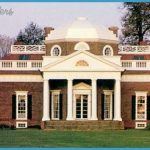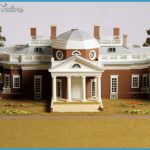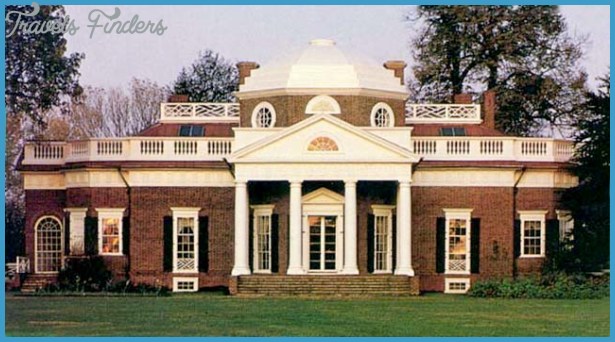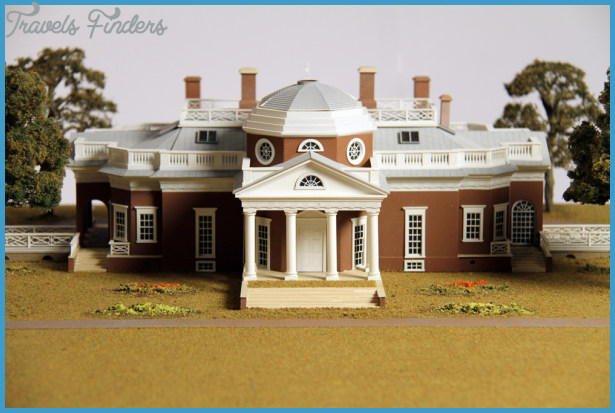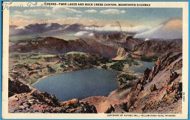THOMAS JEFFERSON
In 1769, when Thomas Jefferson, one of our founding fathers, began to design his own house, the style he chose was neoclassicism. This style was, to some extent, based on the classical architecture of ancient Rome, as interpreted by architects and writers of the Renaissance, especially
Andrea Palladio. From these sources Jefferson took the overall symmetry of his design, which was similar to that of Palladio’s celebrated villas in northern Italy (see pp.124-27). Details such as the columned porticoes also echo Roman and Renaissance architecture.
When Jefferson spent time in France during the 1780s, he found another rich source of neoclassicism in the grand houses of many European cities, and the subtlety of their design seemed to reflect the sophisticated thinking of the Enlightenment, a movement that interested Jefferson. Influenced by the architectural styles prevalent in France, Jefferson then modified his design, adding the octagonal dome and creating a hybrid neoclassicism made up of a mix of ancient and modern elements. Finally, he incorporated features of his own, such as skylights. The resulting house, Monticello (“little mountain), is both innovative and classically restrained, and its design influenced builders and architects in 19th-century North America.
THOMAS JEFFERSON
1743-1826
Born into a family of Virginia plantation owners, Thomas Jefferson had a successful career as a lawyer. He read widely, spoke five languages, and had interests spanning the arts and sciences. In the 1770s he became a member of the group that worked for US independence and was the principal author of the Declaration of Independence. While Minister to France in the 1780s, Jefferson developed strong ideas about architecture. Later, he was the first Secretary of State. He became president for the first of two terms in 1800 and his successes included the purchase of the Louisiana Territory from France.
Visual tour
1 WEST PORTICO Both the east and west porticoes at Monticello have a triangular pediment supported by a row of white columns in a version of the Doric order. Unlike ancient Greek Doric columns (see p.23) they lack flutes, but have bases. The columns on the east portico, which was built first, are made of stone, but skilled stone workers were in short supply, so Jefferson chose to build the west portico columns using specially manufactured curved bricks.
ON DESIGN
Skylight
Thousands of curved bricks make up the columns
Full-height sash window
1 CLASSICAL DETAILS The neoclassical architects of the 18th and 19th centuries based their designs on certain elements, such as columns and pediments, drawn from the buildings of ancient Greece and Rome. They also added elements of their own, such as this parapet, which goes all the way around the building, concealing the roof. While some architects preferred a solid parapet, Jefferson chose one with rows of baluster shafts. This added visual interest and made the structure look lighter.
With its porticoes, dome, and sash windows, Monticello looks like a straightforward neoclassical building, but its sober exterior conceals a number of unusual gadgets and devices that Jefferson, with great ingenuity, incorporated into the fabric of the house. Near the stairs leading to the kitchen in the dining room, he installed a revolving serving door with shelves, together with a dumb waiter to bring wine up from the cellar.
The house had indoor bathrooms, which were unusual at the time. Some of the windows had two sets of sashes for insulation, an early form of double glazing, while the parlor had a set of doors that opened automatically. Other innovations, such as the closet concealed above Jefferson’s bed and accessed by a ladder, involved clever use of space.
1 Compass rose
Linked to a rooftop weather vane, this feature was positioned so that Jefferson could read the wind direction without going outside.
3 JEFFERSON’S BEDROOM The space-saving properties of alcove beds, which he saw in France, appealed to Jefferson. He liked the way in which the bed was tucked away, giving plenty of uncluttered floor space in the bedroom. Jefferson placed his own bed in an alcove between his bedroom and his study, which is visible beyond the bed in the photograph. It created a visual and functional link between the two rooms.
2 TRIPLE-SASH WINDOWS
Many of the rooms, including the parlor, have windows made up of three sliding sashes rather than the pair of sashes more often used in windows of this period. With a triple-sash window that extends to the floor, the two sashes at the bottom can be raised so that the window becomes a door, making it easy to step in and out on warm summer days. Alternatively, lifting the bottom sash and lowering the top sash creates a flow of air for ventilation.
1 ENTRANCE HALL In this reception area Jefferson displayed his most prized possessions such as maps, images showing the early history of the US, and busts of heroes such as the French writer, Voltaire. The ceiling decoration features an eagle and a group of stars (probably representing the number of states in the Union in 1812 when the ceiling was installed). Hanging from the center of the room, a brass oil lamp can be raised and lowered on pulleys.

